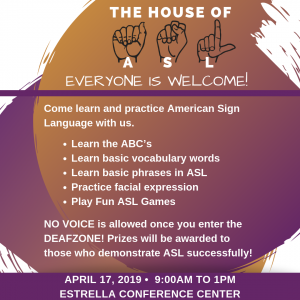Want to learn sign language but don’t know where to start? Estrella Mountain Community College (EMCC) has you covered. The college is hosting The House of ASL from 9 a.m. to 1 p.m. April 17 at the Estrella Conference Center.
This is the fourth time the college has held the event, which takes place every other year in the spring. Previously called “Deaf Deaf World,” The House of ASL will teach American Sign Language ABCs, basic vocabulary words, and basic phrases, just to name a few. Participants will also practice facial expressions and play fun ASL games.
“We changed the name of the event because ASL isn’t just for deaf people,” said Paulus Yalim, ASL instructor and one of The House of ASL committee members. “In general, more and more people are using ASL.”
It generally takes someone about two years to become fluent in ASL, Yalim said.
“But it all depends on one's ability to learn the visual language,” he said. “Some people can learn ASL well in less than two years, but some others will take more than two years to learn.”
However, The House of ASL students should be able to introduce themselves in ASL, sign some words, and sign simple sentences after completing the course, Yalim said. It’s also a great refresher course for people who learned ASL in the past.
“They can ask as many questions as they want about how to sign anything,” he said. “We are more than happy to answer.”
While actually learning ASL is essential, The House of ASL participants will also learn about deaf culture.
“Maybe they never met anyone who is deaf and are not sure how to approach deaf people,” Yalim said. “It is a great opportunity for them to meet us and understand how to communicate via gesture.”
Yalim, who is deaf, has been an ASL instructor for more than 19 years. He said he was inspired to teach ASL because most of his family members can hear but only some of them can communicate with him in ASL.
“I know that other deaf people have a similar experience as mine,” he said. “It would be good if all of them know ASL. Not only is ASL good for family and friends, but also people in general. It shows the beauty of a visual language that people, in general, can experience as they have experienced the beauty of a spoken language.”
It is unknown how many Americans use ASL as the Census Bureau does not track this data, but estimates put it at 250,000 to 500,000. Change.org claims it’s one of the fastest growing languages in America and is the fourth most used and third most taught language in the U.S. EMCC has three deaf instructors and a few deaf students, and this semester alone the college is offering nine ASL classes with 155 students. It’s become so popular that another class will be added next semester.
“I think everyone should know ASL,” Yalim said. “Not just to communicate with deaf people, but also dealing with people with hearing loss due to illness, war, age, etc.”
According to the National Institute on Deafness and Other Communication Disorders (NIDCD), about 2 percent of adults ages 45 to 54 have disabling hearing loss. That rate increases to 8.5 percent for adults ages 55 to 64, 25 percent for ages 65 to 74, and 50 percent for 75-year-olds and older. Although age is the strongest predictor of hearing loss, two to three out of every 1,000 children in the U.S. are born with a detectable level of hearing loss in one or both ears, and 13 percent of Americans 12 and older has hearing loss in both ears, based on standard hearing examinations.
Yalim said even those who don’t need to sign on a regular basis to communicate should learn ASL.
“It also helps hearing people in case they’re stuck in a sound-proof environment, such as underwater or a barrier where sound cannot go through,” he said. “They don’t have to be expert in ASL, but at least they know how to communicate using facial and body expressions. Furthermore, research shows that babies who are learning a language tend to learn some signs first before starting to talk. If parents know both ASL and English and use them with their babies, their babies will develop intelligence both visually and verbally.”
The event is open to students, faculty, staff, and community members. No verbal communication is allowed once participants enter what organizers have dubbed “The Deafzone.”
“They will feel like they’re in The Twilight Zone,” Yalim said.
